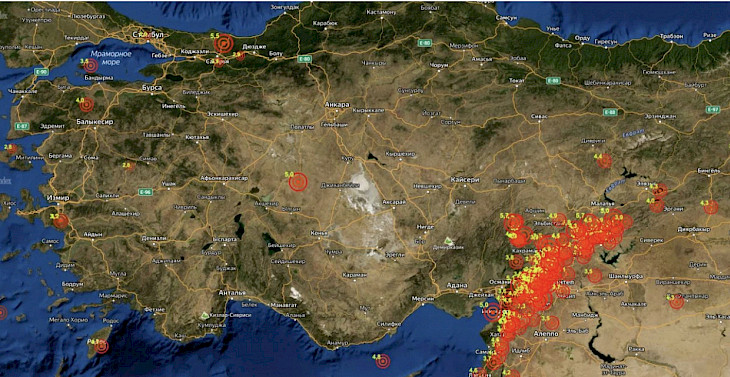After the tragic earthquakes, the Turkish government faces a dilemma: either to radically change the policy in the construction sector, or leave the causes of the tragedy for later.
The CentralasianLIGHT.org publish the article which has been received from professor at Halic University, Istanbul, in Turkey Patrik K. Meyer (USA) for the purpose of discussion. The following is the original text of the author.
A big challenge awaiting Erdogan’s government: Curbing widespread ethical misconduct threatening Turkey’s prosperity
Why most of the massive human and economic losses resulting from Türkiye’s recent earthquakes are to be blamed ondeliberate acts of ethical misconduct.
On February 6th, southern and central Türkiye were struck by two powerful earthquakes that resulted in massive human and economic losses. Hundreds of thousands of buildings wereeither destroyed beyond repair or seriously damaged and in need of full structural retrofit. The collapse of these poorly designed buildings killed over 50’000 people, injured over 100’000, and displace more than three million.
To identify the reasons why such extensive destruction happened, I visited the earthquake affected region twice tosurvey in detail the collapsed and damaged buildings. Also, Italked to numerous local officials, engineers, contractors, and construction workers to understand their perspective of the events. My inquiry found that such a level of destruction canonly be attributed to one or more of the five following reasons.
The first would be if the earthquakes had stricken a region that had been considered of very low seismicity, which would have made it impossible to foresee events of such magnitude. This is, nevertheless, not the case. The region was known for its high seismicity and, while events the magnitude of the recent earthquakes was unusually high, they were within the range of magnitudes that were expected in the region. Hence, it cannot be argued that the disaster was not preventable because the region has been known for its high seismicity.
A second reason could have been that the dominant structural deficiencies that resulted in the massive destruction of buildings had not previously been identified or had no known feasible solutions. After extensively surveying the differentfailure mechanisms, I identified five structural deficiencies that were responsible for most of the structural failures: soft story, short column, inadequate shear capacity of the structure, insufficient structural ductility, substandard design (of joints in particular), subgrade concrete and steel, contractors/workers malpractices, ground liquefaction, and deficient stone masonry. All these structural deficiencies are well-known and documented, and numerous feasible design solutions are readily available. So, again, ignorance cannot be blamed for the massive destruction of buildings.
Another reason could have been that Turkish engineers had not been properly trained to design earthquake-resistantstructures. After extensively discussing with numerous local engineers, it became clear that they are indeed properly trained and have the necessary knowledge and skills to design earthquake-resilient structures. It is relevant to note that most of the damaged structures were very standard and did not represent any design challenge. This is reflected in the fact that none of the 134’000 buildings that had been commissioned by TOKI (Turkish Housing Development Administration) in the earthquake zone suffered any substantial structural damage. Hence, lack of engineering skills cannot be blamed for the massive destruction either.
If Türkiye had well-trained engineers and the structural deficiencies could have been avoided, then a lack of economic resources could be considered as the fourth potential reason why substandard structures were built. Was the earthquake region too poor to attract qualified engineers and to build slightly more costly earthquake-resistant structures? Both Kahramanmaras and Hatay are well-developed and relatively rich regions of Türkiye where housing prices are relatively high. Also, affordable TOKI structures performed flawlessly. Consequently, the destruction cannot be blamed on the lack of economic resources either.
The final possible reason for the poor performance of the buildings could have been that Türkiye’s building code had significantly underestimated the required design loads. While there is room to improve the Turkish building code, which is also the case in every other country, it cannot be argued that is not acceptable. The obvious evidence for this is the excellent performance of the TOKI commissioned structures that were designed and build following the Turkish building code. Thus, the building code is not the reason why hundreds of thousands of structures were damaged.
If the high seismicity of the region was known, the solutionsto the dominant structural deficiencies were available, the Turkish engineers had the skills to design earthquake-resistantstructures, the region was rich enough to pay for them, and the Turkish building code was adequate, why then were so many substandard structures built that ultimately were the cause the calamity?
The answer is unsettling. The main reason why such a human and economic disaster happened is the pervasive unethical behavior in undermining the design, construction, and approval stages of structures which lead to the construction ofa massive substandard building stock. It is so that it can be argued and the over 50’000 lives lost were homicides and that the tens of billions of dollars in losses were theft.
It is only a matter of time for a large earthquake to hit Istanbul and cause an even larger disaster. Two urgent challenges awaiting the freshly re-elected Erdogan government are todrastically curb rampant unethical behaviour that threatens Türkiye’s future and to define a feasible strategy to sanitize itssubstandard building stock.
Photo: From open sources on the Internet
CentralasianLIGHT.org
July 14, 2023

